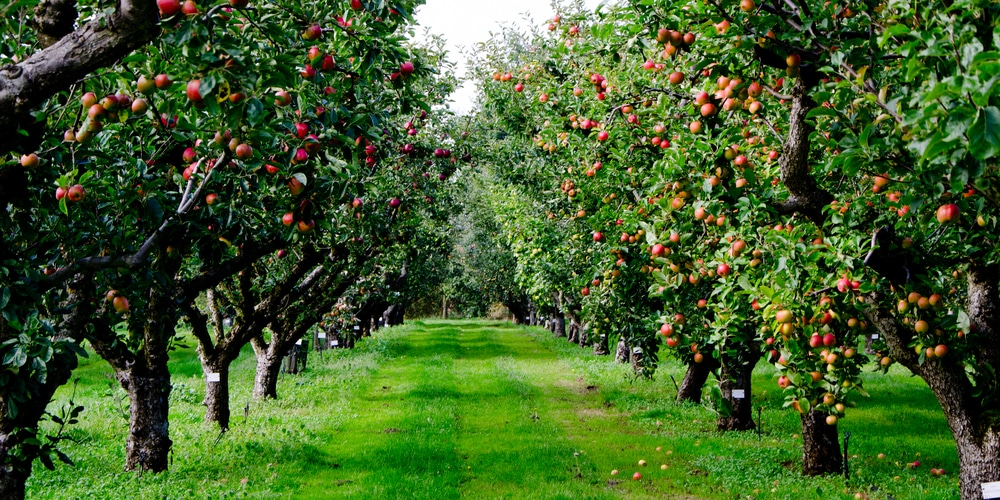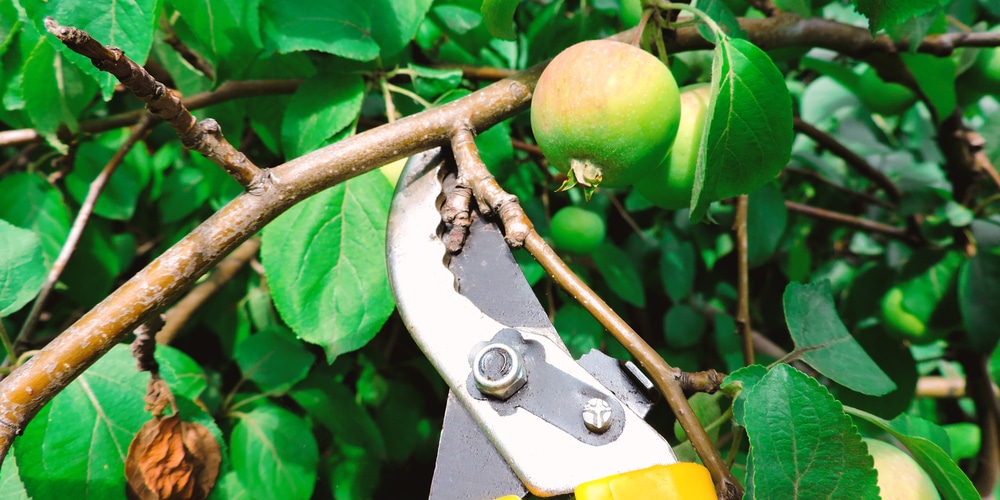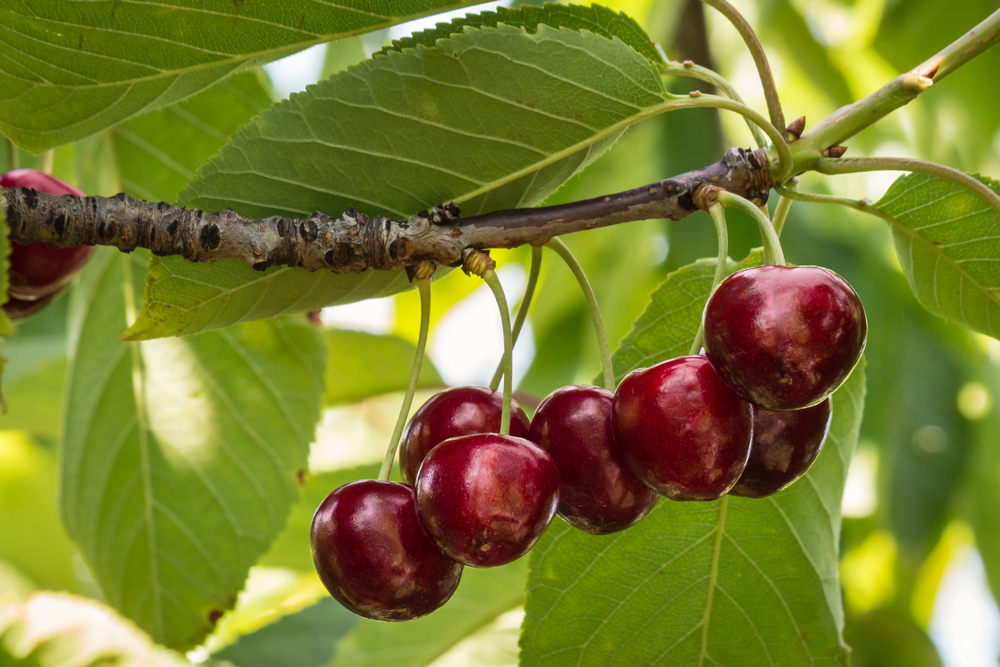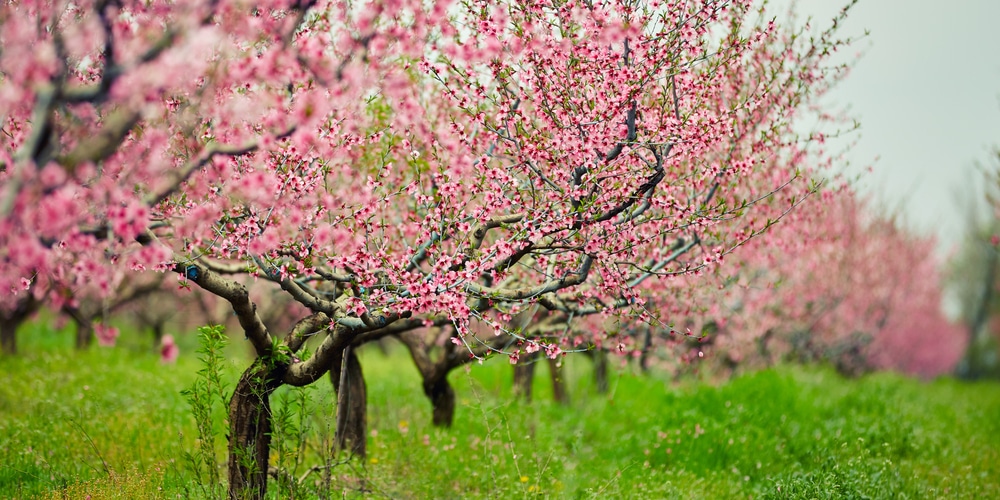How to Choose the Right Tree
When you’re selecting fruit trees for your Illinois yard, keep in mind the state’s varying climate zones.
Your success in fruit tree cultivation hinges on choosing varieties that are robust enough to endure cold winters and the occasional extreme temperature shifts.
- Apple Trees (Malus domestica): Renowned for their hardiness, apple trees are excellent for Northern Illinois. Varieties such as Honeycrisp and Red Delicious offer delicious fruit and resilience.
- Pear Trees (Pyrus spp.): Hardy and productive, Bartlett and D’Anjou pears are suitable and can withstand Illinois winters.
Late Frost Considerations:
- To ward off frost damage, plant your trees after the last frost date. This precaution is especially crucial for:
- Cherry Trees (Prunus spp.): Opt for cold-tolerant varieties like Montmorency and North Star.
Disease Resistance:
- Plum Trees (Prunus domestica): Resistant varieties such as Stanley or Damson plums are recommended.
Soil and Site:
Before planting, test your soil to ensure it’s well-draining and fertile.
Proper sunlight and spacing play a role in your tree’s ability to thrive and produce fruit.
Care Requirements:
- Peaches and Nectarines: These require wrapping in winter to prevent frost damage. They need a little more TLC but can be very rewarding.
Best Practices for Planting and Caring for Fruit Trees
Planting fruit trees in Illinois can provide a bountiful harvest for years to come. Below, you’ll find targeted advice to maximize the health and yield of your fruit trees from the ground up.
Soil Preparation and Requirements
Soil Type: Your fruit trees crave well-draining soil to prevent root diseases.
Illinois typically has rich loamy soil, which is ideal. Before planting, perform a soil test to check for pH and nutrient levels.
Apple trees, for instance, prefer a pH between 6.0 and 7.0, so you may need to amend your soil accordingly.
Organic Matter: Mix in plenty of organic compost to enrich the soil.
This helps to provide a strong foundation by boosting nutrient content and enhancing soil structure.
Planting Guidelines
Hole Size: Dig a hole that’s twice as wide as the tree’s root ball and the same depth. Avoid digging too deep to ensure the tree is planted at the proper level.
- Root Care: Before planting, tease out the roots gently, and ensure they’re not circling or girdling.
- Tree Orientation: If your tree has a graft union, position it facing north-east to shield it from direct sun exposure.
- Supporting: Stake the tree if necessary, especially for dwarf varieties that might have top-heavy canopies.
Watering and Nutritional Needs
Watering: Initially, water your fruit trees generously to settle the soil around the roots.
Establish a regular watering schedule, providing about 1-2 inches per week, depending on rainfall.
In Illinois, spring can be wet, but summer droughts are common. Adjust watering as needed.
Fertilization: After the first year, apply a balanced fertilizer during the growing season.
Avoid high nitrogen fertilizers that can encourage lush foliage but inhibit fruit production.
Instead, opt for a slow-release formula specialized for fruit trees, such as a 10-10-10 blend applied in the spring.
Popular Fruit Tree Varieties in Illinois
When selecting fruit trees for your Illinois yard, consider species that are well-suited to the region’s climate and soil conditions. The following varieties have proven successful and are beloved by gardeners for their hardiness and delicious fruits.
Apple Trees
Malus domestica, or apple trees, are a top choice in Illinois, famed for their adaptability to colder climates.
For Northern Illinois, consider the ‘Honeycrisp’ and ‘Golden Delicious’ cultivars, which offer both cold-hardiness and flavorful fruit. Ensure you have at least two varieties for adequate cross-pollination.
- Harvest time: Typically September to October
- Pollination: Requires a second apple tree for cross-pollination
- Pruning: Late winter
Cherry Trees
Cherry trees thrive in Illinois, with tart varieties such as ‘Montmorency’ and ‘North Star’ excelling in the northern part of the state.
These trees require well-drained soil and are less demanding in terms of care, making them suitable for many gardeners.
- Harvest time: Usually around June to July
- Pollination: Self-fertile or needs a pollinator, depending on the variety
- Pruning: Early spring, when the tree is still dormant
Peach Trees
Peach trees can also flourish in Illinois, particularly when you provide them with proper winter care to shield them from harsher temperatures.
Varieties like the ‘Reliance’ or ‘Red Haven’ are recommended, noted for their frost-hardiness and delectable peaches.
- Harvest time: Generally between July and August
- Pollination: Most are self-fertile
- Pruning: Late winter, for tree health and fruit size
Pest Management and Disease Prevention
Managing pests and preventing disease are crucial to the success of your fruit tree orchard in Illinois.
The initial step in this process is the selection of disease-resistant varieties. When you choose these varieties, you significantly reduce the vulnerability of your trees to common diseases such as apple scab and powdery mildew.
Regular Inspection: You must inspect your trees often for signs of pests or disease. Early detection is key in preventing widespread issues.
Pest Control: There are various methods to control pests. Let’s look at a couple:
- Mechanical: Removing insects by hand or using barriers.
- Biological: Encouraging natural predators or applying nematodes that attack certain pests.
Disease Prevention: To prevent diseases, practice the following:
- Pruning: Keep your trees well-pruned to allow sunlight penetration and air circulation, which can reduce the likelihood of disease.
- Sanitation: Remove any fallen fruit and debris from around your trees to prevent the spread of disease.
Dormant Season Care:
- Winter: Apply dormant sprays like horticultural oils to control overwintering pests and eggs.
Harvesting and Pruning Techniques
For an Illinois yard boasting fruit trees, mastering pruning and harvesting techniques is key to ensuring healthy growth and an abundant yield.
Pruning
Start pruning your fruit trees early in the dormant season to encourage strong structure and remove any undesired growth.
Here’s how to do it efficiently:
- Remove the 3 D’s:
- Dead – branches that show no signs of life.
- Damaged – limbs that are broken or injured.
- Diseased – signs include discoloration or cankers.
- Thin Crossing Branches: Eliminate branches that rub against each other to prevent wounds.
- Cut Back to Healthy Wood: In the case of disease-infested branches like those with fire blight, prune at least 8-10 inches below any discolored bark.
- Shape for Strength: Aim for a wide-angled branch structure for resilience and increased sunlight exposure.
Collecting your bounty at the right time requires awareness of the specific ripening indicators for each type of fruit tree you cultivate. Below are the general steps:
- Check for Ripeness: Gently squeeze the fruit; slight give indicates ripeness.
- Observe Color: Many fruits will reach a species-specific hue when ready.
- Taste Test: Sampling a fruit can be the ultimate test for readiness.
Frequency and Timing: Harvest typically ensues from early summer to late fall, depending on the variety.
Most fruit trees require annual pruning to maintain shape and health.
Always use clean, sharp tools for both harvesting and pruning to protect your trees from potential infection and ensure clean cuts.
Frequently Asked Questions
When selecting the best fruit trees for your Illinois yard, understanding the climate tolerance, care requirements, and suitable varieties is essential for a thriving orchard.
What are some cold-hardy fruit trees suitable for planting in Illinois?
Your Illinois garden can support various cold-hardy fruit trees.
Apple, pear, cherry, and plum trees are known to withstand the harsh winters. It’s important to choose varieties that are well-adapted to Illinois’s cold climate.
Which dwarf fruit tree varieties can thrive in an Illinois yard?
Dwarf apple trees are ideal for smaller spaces in Illinois.
They require less maintenance and are easier to harvest. When looking for a dwarf variety, ensure it’s grafted onto a dwarfing rootstock to control its size.
How do you care for fruit trees in the varying climates of Illinois?
Proper care for fruit trees in Illinois involves strategic planting after the last frost and before extreme heat.
In winter, protect your trees with burlap wraps to buffer against the cold. Seasonal pruning and pest management also play vital roles.
What are the best apple varieties to plant in Illinois gardens?
Some of the best apple varieties for Illinois include the hardy and productive ‘Honeycrisp’, ‘Jonagold’, and ‘Golden Delicious’.
They thrive in the colder northern regions as well as other areas of the state.
Can cherry trees grow well in Illinois, and if so, which varieties are recommended?
Cherry trees do flourish in Illinois, particularly the ‘Montmorency’ and ‘North Star’ sour cherry varieties, known for their cold resistance and flavorful fruit. Sweet cherries can also be grown, but they typically require more care.
Are there any native fruit tree species particularly well-adapted to the Illinois environment?
Persimmons and pawpaws are native to Illinois and are highly adapted to local conditions.
They are resilient and require minimal intervention once established, making them an excellent choice for a low-maintenance orchard.



